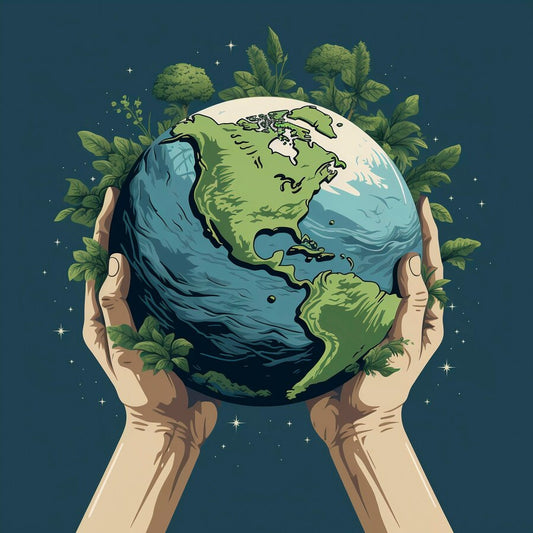It’s been over a year now since I dived into the world of sustainable fashion, looking for the answer to why it sucked so bad and what the solution was.
I thought I’d find simple answers. A Silver Bullet. Perfect Solutions. A clear path.
It was wishful thinking!
What I found instead was that most decisions involve trade-off’s. That there was no perfect. That it was hard to find 100% great for our planet. In fact the only thing I could say was perfect for our planet was being naked (obviously not a great option unless on certain beaches or establishments!).
The Materials clothes are made of is a great example of this. When I started my journey I assumed anything natural was good, and anything not natural was bad. Then I found out cotton was one of the worst (but not if it’s organic or recycled - more nuance!) and a man made substance, Tencell Lyocell, was one of the best!
But, having said all that, there have emerged some winners, losers, and then some in-betweeners amongst materials used in fashion. I’ll be expanding on each and why in future articles, but here’s my list of The Good, The Bad and The In-Between of the material world!
The bad!
📛Plastic - this is obvious. Plastic is bad for our environment. Clothes made from it are unrecyclable and do not biodegrade. And everytime you wash them they leach microplastics. NOT good!
📛(non-organic) Cotton - so when we say non-organic that means to be clear chemicals are used. Cotton sucks in many ways - it uses loads of water, and loads of land. This is compounded by the use of loads of pesticides and other nasty chemicals that make their way into our environment.
The In-Between!
🆗Recycled Plastic - this is better than virgin plastic - up to 42% lower carbon emissions. But it’s still plastic - it leaches microplastics when you wash clothes. Garments made with it can’t be recycled (and don’t biodegrade).
And there is the issue of where the plastic comes from - most of it comes from recycled drinks bottles. If you recycled a plastic drinks bottle into a plastic drinks bottle, then you can repeat this process up to 6 times. Do it with clothes and it’s only once. So it shortens the life of plastic, and also takes plastic away from industries that can reuse it more.
🆗Organic Cotton - this is much better than non-organic cotton because no chemicals are used, which is great for our environment.
BUT it still has issues with water and land. The water one is debated - some say it uses less water but the report this is based on is heavily disputed. We can’t say for sure. And it still needs a lot of land, and good land, to grow. So it’s a mixed picture.
🆗Wool - Wool itself is great. As a material it's fantastic to make clothes. It’s breathable, it adjusts to your body temperature, so it keeps us cool in summer and warm in the winter! It comes from a natural source, it’s biodegradable and sheep have a pretty minimal impact on our planet.
The issue comes from the treatment of the sheep themselves. Firstly to cut infection most sheep are docked (tails cut off) and subjected to something called mulesing where skin is cut from their bum, usually with on anaesthetic. And when they are done producing wool, these sheep will be slaughtered. We still think at Stix it’s sustainable properties outweigh this, but it must be acknowledged the impact it has on sheep.
The Great!
👍Recycled Cotton (told you it was complicated!) - because you are reusing it, this is creating a circular economy which is good for our planet. Simple as that!
👍Organic Hemp - The Hemp plant is awesome! It’s rock hard - so it needs little water, no chemicals and can grow on terrible land (so freeing up the good stuff for things like growing food!). It gives back to the soil up to 70% of the nutrients it takes. And it’s biodegradable. It's great for our planet!
👍Organic Linen - Linen comes from the flax plant, which like Hemp is rock hard. And so like hemp, it needs little water, no chemicals and can grow on terrible land. And like hemp, it's natural and so biodegradable.
Water, chemicals, land - these are the 3 biggest issues fashion has when sourcing materials. The flax plant, like hemp, comes up trumps on all 3!
👍Tencell Lyocell (plus a more futuristic plant based materials) - Lyocell (Tencel is the brand) is a man made fibre made from wood pulp. It’s biodegradable and uses way less water, chemicals and dyes than non-sustainable sources. It’s also super versatile and can be used for all sorts of different types of clothes. It’s a brilliant material and an example of how innovation can continue to supply more sustainable materials to the fashion industry.
A man made fibre being good for our planet - who would have thought it!
What's on Stix?
Our collections are free of The Bad.
Everything else comes from The In-Between and The Good.
The reason we have clothes from the in-betweeners is primarily about supply. Most brands really tackling this are small and independent. Right now, sustainable materials are more expensive than non-sustainable one’s. They are
The second reason is that they are still better than The Bad.
Our ultimate aim is to shift as much of our collection to The Good over time as we can. And we are aiming to eliminate Recycled Plastic as soon as we possibly can. This will happen as the fashion industry evolves, as our brands become more successful (which comes down to people buying more of their clothes, which is a key way we think Stix can help change the industry) and when consumers become more educated about what and how they buy.
Stix is here to accelerate that trend and to do our part to eliminate The Bad completely, to eliminate recycled plastic completely, and to transition as much of our collection to The Good as soon as we can.




